Naren Ramakrishnan
Virginia Tech
Optimizing Product Provenance Verification using Data Valuation Methods
Feb 21, 2025Abstract:Determining and verifying product provenance remains a critical challenge in global supply chains, particularly as geopolitical conflicts and shifting borders create new incentives for misrepresentation of commodities, such as hiding the origin of illegally harvested timber or stolen agricultural products. Stable Isotope Ratio Analysis (SIRA), combined with Gaussian process regression-based isoscapes, has emerged as a powerful tool for geographic origin verification. However, the effectiveness of these models is often constrained by data scarcity and suboptimal dataset selection. In this work, we introduce a novel data valuation framework designed to enhance the selection and utilization of training data for machine learning models applied in SIRA. By prioritizing high-informative samples, our approach improves model robustness and predictive accuracy across diverse datasets and geographies. We validate our methodology with extensive experiments, demonstrating its potential to significantly enhance provenance verification, mitigate fraudulent trade practices, and strengthen regulatory enforcement of global supply chains.
Oreo: A Plug-in Context Reconstructor to Enhance Retrieval-Augmented Generation
Feb 20, 2025Abstract:Despite the remarkable capabilities of Large Language Models (LLMs) in various NLP tasks, they remain vulnerable to hallucinations due to their limited parametric knowledge and lack of domain-specific expertise. Retrieval-Augmented Generation (RAG) addresses this challenge by incorporating external document retrieval to augment the knowledge base of LLMs. In this approach, RAG retrieves document chunks from an external corpus in response to a query, which are then used as context for the downstream language model to generate an answer. However, these retrieved knowledge sources often include irrelevant or erroneous information, undermining the effectiveness of RAG in downstream tasks. To overcome this limitation, we introduce a compact, efficient, and pluggable module designed to refine external knowledge sources before feeding them to the generator. The module reconstructs retrieved content by extracting the most relevant and supportive information and reorganising it into a concise, query-specific format. Through a three-stage training paradigm - comprising supervised fine-tuning, contrastive multi-task learning, and reinforcement learning-based alignment - it prioritises critical knowledge and aligns it with the generator's preferences. This method enables LLMs to produce outputs that are more accurate, reliable, and contextually appropriate.
Chasing the Timber Trail: Machine Learning to Reveal Harvest Location Misrepresentation
Feb 19, 2025Abstract:Illegal logging poses a significant threat to global biodiversity, climate stability, and depresses international prices for legal wood harvesting and responsible forest products trade, affecting livelihoods and communities across the globe. Stable isotope ratio analysis (SIRA) is rapidly becoming an important tool for determining the harvest location of traded, organic, products. The spatial pattern in stable isotope ratio values depends on factors such as atmospheric and environmental conditions and can thus be used for geographical identification. We present here the results of a deployed machine learning pipeline where we leverage both isotope values and atmospheric variables to determine timber harvest location. Additionally, the pipeline incorporates uncertainty estimation to facilitate the interpretation of harvest location determination for analysts. We present our experiments on a collection of oak (Quercus spp.) tree samples from its global range. Our pipeline outperforms comparable state-of-the-art models determining geographic harvest origin of commercially traded wood products, and has been used by European enforcement agencies to identify illicit Russian and Belarusian timber entering the EU market. We also identify opportunities for further advancement of our framework and how it can be generalized to help identify the origin of falsely labeled organic products throughout the supply chain.
DMWM: Dual-Mind World Model with Long-Term Imagination
Feb 11, 2025Abstract:Imagination in world models is crucial for enabling agents to learn long-horizon policy in a sample-efficient manner. Existing recurrent state-space model (RSSM)-based world models depend on single-step statistical inference to capture the environment dynamics, and, hence, they are unable to perform long-term imagination tasks due to the accumulation of prediction errors. Inspired by the dual-process theory of human cognition, we propose a novel dual-mind world model (DMWM) framework that integrates logical reasoning to enable imagination with logical consistency. DMWM is composed of two components: an RSSM-based System 1 (RSSM-S1) component that handles state transitions in an intuitive manner and a logic-integrated neural network-based System 2 (LINN-S2) component that guides the imagination process through hierarchical deep logical reasoning. The inter-system feedback mechanism is designed to ensure that the imagination process follows the logical rules of the real environment. The proposed framework is evaluated on benchmark tasks that require long-term planning from the DMControl suite. Extensive experimental results demonstrate that the proposed framework yields significant improvements in terms of logical coherence, trial efficiency, data efficiency and long-term imagination over the state-of-the-art world models.
LLM Augmentations to support Analytical Reasoning over Multiple Documents
Nov 25, 2024
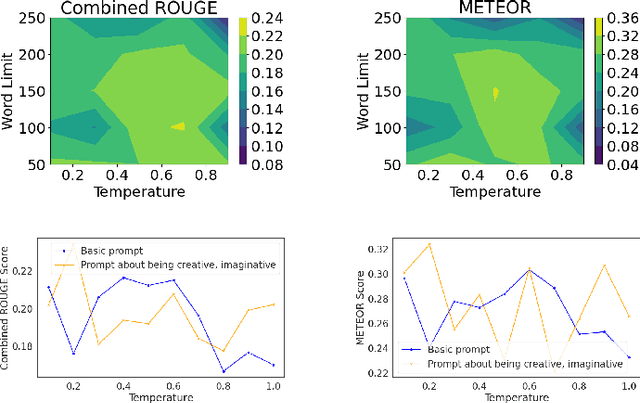
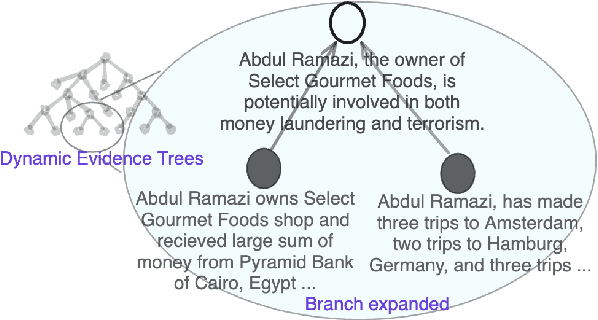

Abstract:Building on their demonstrated ability to perform a variety of tasks, we investigate the application of large language models (LLMs) to enhance in-depth analytical reasoning within the context of intelligence analysis. Intelligence analysts typically work with massive dossiers to draw connections between seemingly unrelated entities, and uncover adversaries' plans and motives. We explore if and how LLMs can be helpful to analysts for this task and develop an architecture to augment the capabilities of an LLM with a memory module called dynamic evidence trees (DETs) to develop and track multiple investigation threads. Through extensive experiments on multiple datasets, we highlight how LLMs, as-is, are still inadequate to support intelligence analysts and offer recommendations to improve LLMs for such intricate reasoning applications.
Information Guided Regularization for Fine-tuning Language Models
Jun 20, 2024



Abstract:The pretraining-fine-tuning paradigm has been the de facto strategy for transfer learning in modern language modeling. With the understanding that task adaptation in LMs is often a function of parameters shared across tasks, we argue that a more surgical approach to regularization needs to exist for smoother transfer learning. Towards this end, we investigate how the pretraining loss landscape is affected by these task-sensitive parameters through an information-theoretic lens. We then leverage the findings from our investigations to devise a novel approach to dropout for improved model regularization and better downstream generalization. This approach, named guided dropout, is both task & architecture agnostic and adds no computational overhead to the fine-tuning process. Through empirical evaluations, we showcase that our approach to regularization yields consistently better performance, even in scenarios of data paucity, compared to standardized baselines.
Are LLMs Naturally Good at Synthetic Tabular Data Generation?
Jun 20, 2024



Abstract:Large language models (LLMs) have demonstrated their prowess in generating synthetic text and images; however, their potential for generating tabular data -- arguably the most common data type in business and scientific applications -- is largely underexplored. This paper demonstrates that LLMs, used as-is, or after traditional fine-tuning, are severely inadequate as synthetic table generators. Due to the autoregressive nature of LLMs, fine-tuning with random order permutation runs counter to the importance of modeling functional dependencies, and renders LLMs unable to model conditional mixtures of distributions (key to capturing real world constraints). We showcase how LLMs can be made to overcome some of these deficiencies by making them permutation-aware.
Laying Anchors: Semantically Priming Numerals in Language Modeling
Apr 02, 2024Abstract:Off-the-shelf pre-trained language models have become the de facto standard in NLP pipelines for a multitude of downstream tasks. However, the inability of these models to properly encode numerals limits their performance on tasks requiring numeric comprehension. We introduce strategies to semantically prime numerals in any corpus by generating anchors governed by the distribution of numerals in said corpus, thereby enabling mathematically grounded representations of these numeral tokens. We establish the superiority of our proposed techniques through evaluation on a range of numeracy tasks for both in-domain (seen) and out-domain (unseen) numerals. Further, we expand our empirical evaluations to numerals ranging from 1 to 10 billion, a significantly broader range compared to previous studies of the same nature, and we demonstrate significant improvements in the mathematical grounding of our learned embeddings.
Large Multi-Modal Models (LMMs) as Universal Foundation Models for AI-Native Wireless Systems
Feb 07, 2024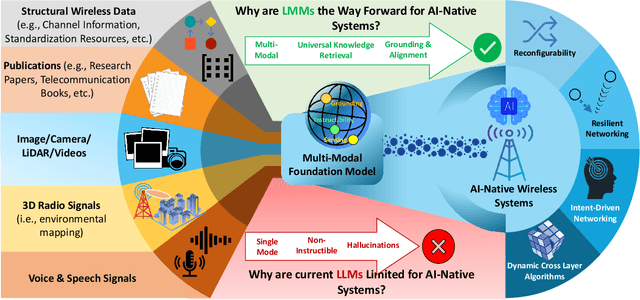
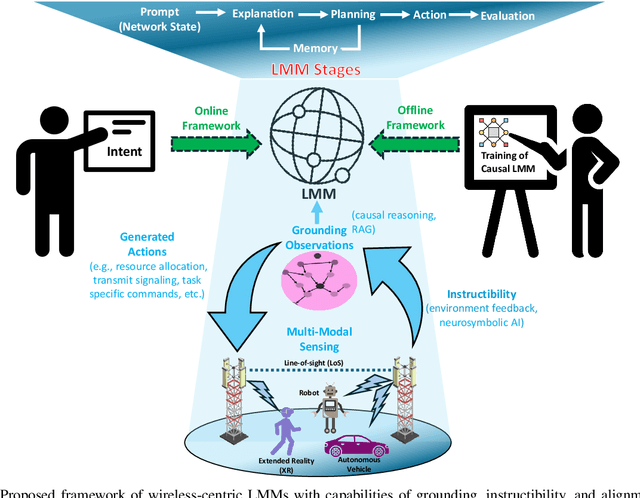
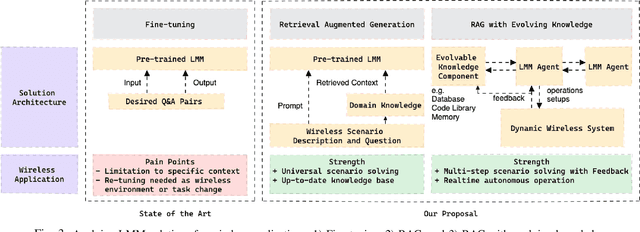
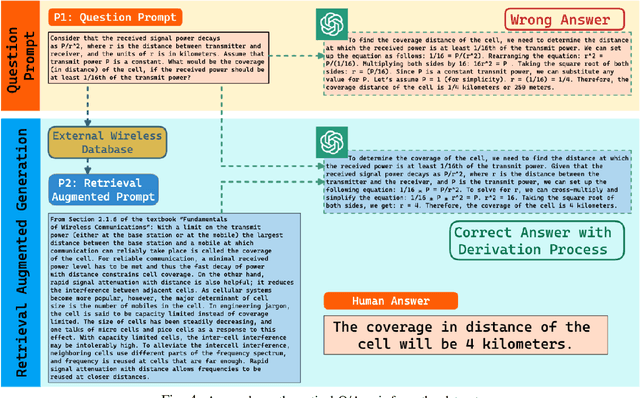
Abstract:Large language models (LLMs) and foundation models have been recently touted as a game-changer for 6G systems. However, recent efforts on LLMs for wireless networks are limited to a direct application of existing language models that were designed for natural language processing (NLP) applications. To address this challenge and create wireless-centric foundation models, this paper presents a comprehensive vision on how to design universal foundation models that are tailored towards the deployment of artificial intelligence (AI)-native networks. Diverging from NLP-based foundation models, the proposed framework promotes the design of large multi-modal models (LMMs) fostered by three key capabilities: 1) processing of multi-modal sensing data, 2) grounding of physical symbol representations in real-world wireless systems using causal reasoning and retrieval-augmented generation (RAG), and 3) enabling instructibility from the wireless environment feedback to facilitate dynamic network adaptation thanks to logical and mathematical reasoning facilitated by neuro-symbolic AI. In essence, these properties enable the proposed LMM framework to build universal capabilities that cater to various cross-layer networking tasks and alignment of intents across different domains. Preliminary results from experimental evaluation demonstrate the efficacy of grounding using RAG in LMMs, and showcase the alignment of LMMs with wireless system designs. Furthermore, the enhanced rationale exhibited in the responses to mathematical questions by LMMs, compared to vanilla LLMs, demonstrates the logical and mathematical reasoning capabilities inherent in LMMs. Building on those results, we present a sequel of open questions and challenges for LMMs. We then conclude with a set of recommendations that ignite the path towards LMM-empowered AI-native systems.
Learning Non-linguistic Skills without Sacrificing Linguistic Proficiency
May 14, 2023Abstract:The field of Math-NLP has witnessed significant growth in recent years, motivated by the desire to expand LLM performance to the learning of non-linguistic notions (numerals, and subsequently, arithmetic reasoning). However, non-linguistic skill injection typically comes at a cost for LLMs: it leads to catastrophic forgetting of core linguistic skills, a consequence that often remains unaddressed in the literature. As Math-NLP has been able to create LLMs that can closely approximate the mathematical skills of a grade-schooler or the arithmetic reasoning skills of a calculator, the practicality of these models fail if they concomitantly shed their linguistic capabilities. In this work, we take a closer look into the phenomena of catastrophic forgetting as it pertains to LLMs and subsequently offer a novel framework for non-linguistic skill injection for LLMs based on information theoretic interventions and skill-specific losses that enable the learning of strict arithmetic reasoning. Our model outperforms the state-of-the-art both on injected non-linguistic skills and on linguistic knowledge retention, and does so with a fraction of the non-linguistic training data (1/4) and zero additional synthetic linguistic training data.
 Add to Chrome
Add to Chrome Add to Firefox
Add to Firefox Add to Edge
Add to Edge